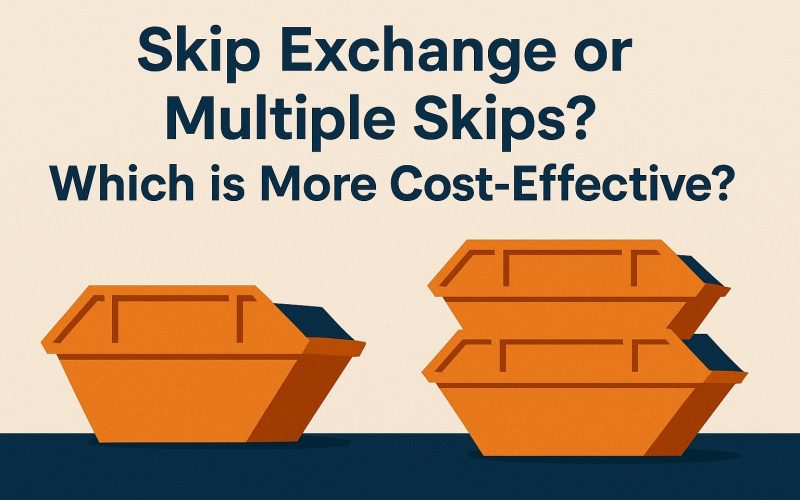
Rachel writes practical guides on skip hire, waste removal, and responsible disposal in the UK. She explains what you can legally put in a skip, how to handle restricted waste, and what it really costs. Her goal is to give clear, up-to-date advice so households and trades stay compliant and avoid fines.
Reviewed by: Skip Hire Team Waste Compliance Manager | Upper Tier Waste Broker Licence CBDU596771

We know how quickly waste can build up. No matter the project, whether it is a renovation or a garden-clear out, it’s hard to predict the amount of waste. That’s why it’s easier to hire a skip and arrange exchanges.
One thing to remember, the answer depends on your project. Let’s break it all down so you can make the best call for your job and your budget.
| Your Situation | Best Option | Why? |
|---|---|---|
|
Project lasts over a week
|
Skip Exchange
|
Keeps your site clear without delays — no need for multiple bookings
|
|
Waste builds up in stages or short bursts
|
Multiple Skips
|
Pay only for what you need, when you need it
|
|
You’re dealing with different waste types
|
Multiple Skips
|
Legal requirement for hazardous waste segregation
|
|
Very limited space or shared driveways
|
Skip Exchange
|
Reduces vehicle visits, neighbour disruption, and planning hassle
|
Think of a skip exchange like a quick swap: when one skip’s full, we collect it and instantly drop off another empty one. No time wasted and you don’t have to lift a finger. But let’s break it down more:
There’s an alternative option. Hiring one skip at a time gives you more control over your spend and sizing. You fill one, we collect it, and when you’re ready, you order another. It’s that simple.
| FEATURE | SKIP EXHANGE | MULTIPLE SKIPS |
|---|---|---|
|
Cost Per Trip
|
Slightly higher
|
Fixed per hire
|
|
Convenience
|
Very high (no delays)
|
Medium (you book as needed)
|
|
Flexibility
|
One size usually
|
Choose per job
|
|
Best For
|
Ongoing, high-volume jobs
|
Smaller, phased projects
|
If it’s a long project (a week or more), skip exchanges can save you time and hassle. No waiting around. For short jobs (under 3–4 days), multiple skip hires are likely cheaper.
If you’re removing things like:
• Asbestos (needs a licensed skip)
• Plasterboard (must be separated)
• Soil or rubble (heavy-duty skips)
You’ll likely need separate skips anyway. So multiple skip hires win out here.
Tight on driveway room or working in a narrow street? A skip exchange can cut down on traffic and hassle. Fewer drop-offs and collections mean less disruption.
Permits, builder downtime, and even emergency skip swaps can eat into your budget. Skip exchanges avoid some of those unexpected delays, ensuring you project keeps running smoothly.
Choosing the right waste setup isn’t just about money — it’s about sustainability too.
We divert up to 92% of waste from landfill through responsible sorting (much higher than the industry average of 73%.)
No matter which option you take, picking the right size skip makes a big difference and will save you from an unnecessary headache.
There’s no one-size-fits-all answer because it all really depends on your job, your space, and how waste-heavy your project is. But now you’ve got the facts to choose what works best for your timeline and your budget.
Need help picking the right skip size or setup? Our team’s just a call away.
